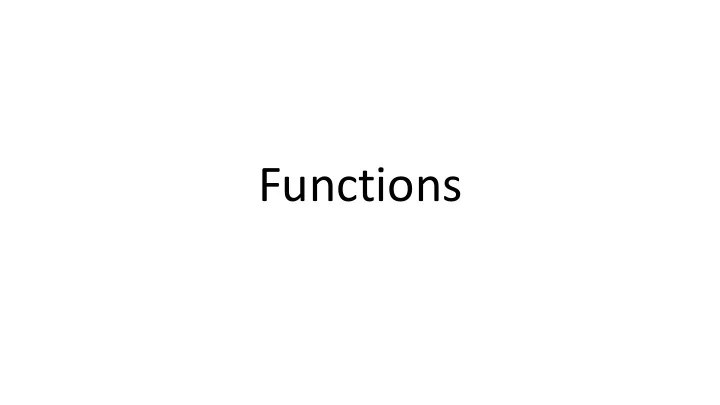

Functions
Simple Functions Definition: def function_name (): ... code goes here ... Calling: function_name () Functions can only be called after they have been declared!
Simple Functions def greet(): print(“Well, hello there!”) greet()
Functions With Parameters Definition: def function_name ( param1 , param2 , etc... ): ... code goes here ... Calling: function_name ( value1 , value2 , etc... )
Functions With Parameters def greet(name): print(“Hello, %s!” % (name)) greet(“Alex”)
Exercise: Sum and Product Function Write a function that takes two numbers, and prints their sum and their product. Call this function several times with different values.
Exercise: Sum and Product Function Write a function that takes two numbers, and prints their sum and their product. Call this function several times with different values. def sum_and_product(x, y): print(“Sum: %d” % (x + y)) print(“Product: %d” % (x * y)) sum_and_product(2, 3) sum_and_product(8, 12) sum_and_product(10, 10)
Returning a Value Terminate a function with: return Terminate a function, returning a value, with: return some_value
Returning a Value def myfunction(): print(“Hi there!”) return print(“This message will never be shown...”) myfunction()
Returning a Value def add(x, y): return x + y z = add(3, 4) print(z) # Outputs 7
Exercise: Circle Properties r = float(input(“Radius: “)) pi = 3.14159 circ = 2 * pi * r area = pi * r * r print(“Circumference: %f” % circ) print(“Area: %f” % area) Rewrite this program to use two functions: one to calculate and return the circumference, and one to calculate and return the area. Take an input radius, pass it to both functions, and print the values returned.
Exercise: Circle Properties pi = 3.15159 def circ(r): return 2 * pi * r def area(r): return pi * r * r r = float(input(“Radius: “)) print(“Circumference: %f” % circ(r)) print(“Area: %f” % area(r))
Returning Multiple Values We can return any data type we want! To return multiple values, just bundle them up in a tuple (or list, or other compound data structure). def sum_and_product(x, y): return (x + y, x * y) (s, p) = sum_and_product(6, 7) # s = 13 # p = 42
Variable Scope Scope: What part of the program a variable exists in. Global scope: Accessible throughout the program. Variables defined in the main program have global scope. Local scope: Accessible only in a particular function. Variables defined in a function have scope local to that function. Local variables have priority over global variables if their names clash.
Variable Scope pi = 3.15159 def circ(r): return 2 * pi * r def area(r): return pi * r * r r = float(input(“Radius: “)) print(“Circumference: %f” % circ(r)) print(“Area: %f” % area(r))
Default Parameters def greet(name = “User”): print(“Hello, %s!” % (name)) greet(“Alex”) # “Hello, Alex!” greet() # “Hello, User!”
Default Parameters def greet(name = “User”): print(“Hello, %s!” % (name)) greet(“Alex”) # “Hello, Alex!” greet() # “Hello, User!” Default parameters must come at the end: def good(a, b = 2) def bad(a = 6, b)
Specify Parameters by Name def greet(greeting, name): print(“%s, %s!” % (greeting, name)) Normally, we might call: greet(“Hello”, “Alex”) But we could also use: greet(name = “Alex”, greeting = “Hello”)
Varying Number of Parameters def many_args(param1, param2, *otherparams): ... some code ... Calling: many_args(4, “hello”, “x”, “y”, “z”) Will set the parameters of many_args to: param1 = 4 param2 = “hello” otherparams = (“x”, “y”, “z”)
Passing by Reference - Watch Out! In Python, values are passed to function parameters ‘ by reference ’. This means that, even though the variables in your function are different to those you might have passed in, they both refer to the same memory . This shouldn’t be much of a problem until we cover classes and objects in a future lesson.
Passing by Reference - Watch Out! def myfunction(y): def myfunction(y): y = 5 y.append(5) x = 2 x = [2, 4] print(x) # x is 2 print(x) # x is [2, 4] myfunction(x) myfunction(x) print(x) # x is 2 print(x) # x is [2, 4, 5]
Recursion A function can call another function: def myfunction(): print(“Hi!”) def otherfunction(): myfunction() print(“Other function”) So naturally, a function could also call itself!
Recursion We should avoid looping forever … def badfunction(): print(“Let’s go on forever!”) badfunction() To be useful, a recursive function will need a terminating condition.
Recursion Calculating integer powers (really inefficiently!): def power(x, n): if n == 1: return x else: return x * power(x, n - 1)
Exercise: Factorial The factorial (!) of a number is defined as the product of every integer between 1 and that number. e.g. 5! = 1 * 2 * 3 * 4 * 5 = 120 Write a recursive function find the factorial of an input.
Exercise: Factorial def factorial(x): if x == 1: return x else: return x * factorial(x - 1)
Recommend
More recommend